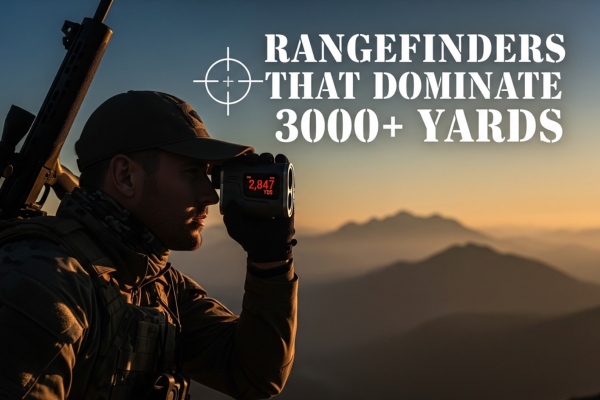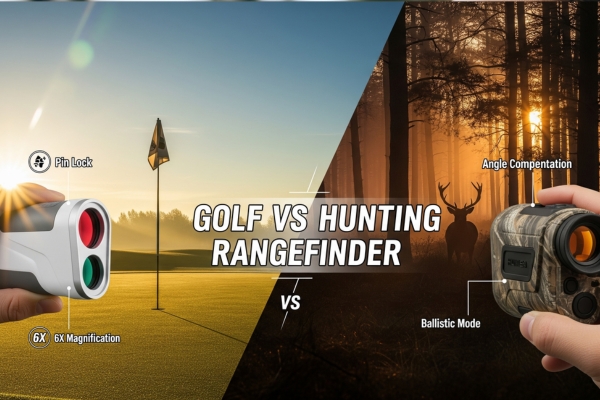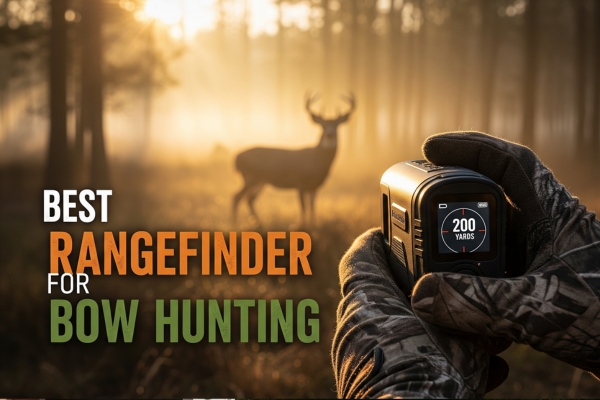



Whether your rangefinder batteries died at the worst moment or you prefer the challenge of traditional hunting, knowing how to judge distance without technology can make the difference between a successful shot and a missed opportunity. Every hunter and shooter should master at least one reliable method for estimating range when technology isn’t available.
The good news? You can learn to judge distance without a rangefinder using seven field-tested methods: the thumb technique, scope reticle calculations, 20-yard increments, pacing, known object sizes, multi-pin sights, and environmental reading. Each method offers different accuracy levels, from basic 50-yard estimates to precise calculations beyond 500 yards.
This comprehensive guide will teach you practical techniques used by military snipers, competition shooters, and experienced hunters. You’ll discover the science behind distance perception, master multiple estimation methods, and learn how to practice effectively in any conditions.
Modern rangefinders are incredibly reliable, but Murphy’s Law loves hunting season. Dead batteries, heavy rain, or dense fog can render your expensive device useless at the critical moment. Equipment failure happens when you least expect it.
Having backup skills for judging distance without a rangefinder ensures you’re never completely helpless. Think of it like knowing how to use a compass when your GPS fails – it’s an essential survival skill for serious outdoorsmen.
Learning to measure distance without rangefinder technology develops your natural instincts and spatial awareness. These skills make you a more complete hunter, improving your overall field craft and decision-making abilities.
Old-school hunters relied entirely on these techniques for generations. By mastering them, you connect with hunting traditions while becoming less dependent on technology. This knowledge builds confidence and self-reliance in the field.
Here are critical scenarios where manual distance estimation becomes essential:
• Archery hunting in thick timber – No time to range when a buck appears at 20 yards • Spot-and-stalk situations – Movement with a rangefinder could spook your quarry
• Competition shooting – Some events prohibit electronic devices • Military/tactical applications – Stealth operations require silent ranging • Backup for equipment failure – When batteries die or devices malfunction
Understanding depth of field principles helps explain why distance judgment can be challenging. Your brain uses several visual cues to estimate range: relative size, overlapping objects, atmospheric perspective, and binocular disparity.
The human visual system evolved for distances under 100 yards. Beyond this range, our natural depth perception becomes increasingly unreliable without reference points or training.
Light conditions dramatically impact how we gauge distance without rangefinder assistance. Bright sunlight makes objects appear closer, while shadows and overcast conditions create the opposite effect. Understanding these factors is crucial for accurate estimation.
Similarly, terrain features can trick your eyes. Clear air in mountains makes distant objects seem closer, while humidity and haze increase perceived distance. Flat, featureless terrain offers fewer reference points, making estimation especially difficult.
Your eyes work like cameras, using focal length and perspective to judge distance. Objects appear smaller as distance increases following predictable mathematical relationships. This principle forms the foundation for several estimation techniques.
| Factor | Effect on Distance Perception | Compensation Method |
|---|---|---|
| Bright Light | Objects appear closer | Add 10-15% to estimate |
| Shadows/Overcast | Objects appear farther | Subtract 10% from estimate |
| Uphill Viewing | Targets seem farther | Reduce estimate by 20% |
| Downhill Viewing | Targets seem closer | Increase estimate by 20% |
| Clear Mountain Air | Objects appear closer | Add 25% to estimate |
This classic military technique relies on a simple anatomical fact: your arm length is approximately 10 times the distance between your eyes. This consistent ratio allows for surprisingly accurate distance calculations using just your thumb and some basic math.
The method works because of parallax – the apparent shift in an object’s position when viewed from different angles. By measuring this shift against a known reference (your thumb width), you can calculate range without rangefinder tools.
Follow these steps for the best way to judge distance without rangefinder using the thumb method:
The thumb method typically provides accuracy within 10-20% at ranges under 500 yards. Your results improve significantly with practice and when estimating the “jump” distance against known-sized objects.
Limitations include difficulty with small targets, reduced accuracy beyond 500 yards, and challenges in low light. Wind can also make holding a steady position difficult, affecting your measurement.
Rifle scopes with MOA (Minute of Angle) reticles offer precise distance calculation for shooting when you know your target’s size. Bushnell’s ranging guide explains that one MOA equals 1.047 inches at 100 yards.
The formula is straightforward: Distance (yards) = (Target Size in Inches × 95.5) ÷ MOA Measurement. This mathematical approach eliminates guesswork when you have time for calculations.
For example, if a deer’s chest (18 inches) covers 3 MOA in your reticle, the calculation is: (18 × 95.5) ÷ 3 = 573 yards. Keep a range card with common calculations for faster field use.
Mil-dot reticles use the milliradian system, popular in tactical and long-range shooting. The formula for how to calculate distance for shooting with mils is: Distance (yards) = (Target Size in Inches × 27.8) ÷ Mil Measurement.
This system excels for precise ranging because mils divide into tenths easily. A target measuring 36 inches that spans 2.5 mils would be: (36 × 27.8) ÷ 2.5 = 400 yards away.
First Focal Plane (FFP) scopes simplify ranging because the reticle scales with magnification. Your measurements remain accurate at any power setting, making field calculations faster and more reliable.
Second Focal Plane (SFP) scopes require specific magnification settings for accurate ranging, typically maximum power. Always verify your scope’s specifications before relying on reticle ranging in the field.
| Reticle Type | Formula | Best For |
|---|---|---|
| MOA | (Size × 95.5) ÷ MOA = Yards | Hunters, general shooting |
| MRAD/Mil | (Size × 27.8) ÷ Mils = Yards | Tactical, long-range |
| Standard Duplex | Reference points only | Quick estimates |
The 20-yard increment method is arguably the best way to judge distance without rangefinder for shots under 100 yards. Most shooters can accurately visualize 20 yards because it’s a common practice distance. This familiar reference becomes your measuring stick.
Start by developing an intimate knowledge of what 20 yards looks like from various angles and lighting conditions. Practice in your backyard, at the range, and in different terrains until this distance becomes second nature.
Once you’ve mastered recognizing 20 yards, use it to measure distance without rangefinder by visually “walking” forward in increments. Look at a spot 20 yards away, then find another point 20 yards beyond that, continuing until you reach your target.
This technique works best on relatively flat terrain with visible landmarks. For a target at 80 yards, you’d identify four 20-yard segments between you and the target. The method becomes less accurate beyond 100 yards but excels for archery and short-range shooting.
Improve your increment estimates by practicing with these proven techniques:
• Use consistent landmarks – Trees, rocks, or fence posts at each increment • Account for terrain changes – Uphill segments appear longer than reality • Practice in various conditions – Different light affects perception significantly • Verify with pacing – Walk your estimates occasionally to calibrate • Start with shorter increments – Use 10-yard segments for targets under 50 yards
Pacing remains one of the most reliable methods for walking distance without rangefinder tools, especially when pre-ranging hunting spots. Most adults’ natural stride measures 2.5 to 3 feet, but determining your exact measurement is crucial.
To calibrate, measure a 100-foot distance on level ground. Walk it naturally while counting steps, repeat five times, then calculate your average stride length. This becomes your personal constant for all distance calculations.
Smart hunters arrive early to pace distances from their stands to key landmarks. This preparation eliminates guesswork when game appears and allows for confident shot placement without electronic assistance.
Create a mental map noting distances to prominent features: large trees, trail intersections, fence posts, or unique rocks. Understanding composition and landmarks helps organize these reference points effectively.
Professional marksmen use range cards to quickly reference distances without measurement. You can create similar mental maps for your hunting areas, noting key distances and landmarks from your typical positions.
Include terrain features that affect bullet trajectory: elevation changes, wind corridors, and obstacles. Update these mental notes seasonally as vegetation changes can alter visibility and reference points.
Knowing average animal dimensions helps gauge distance without rangefinder when game appears. A mature whitetail deer’s chest measures 18-20 inches, while an elk’s chest spans 24-26 inches. These consistent measurements provide ranging references.
Use body parts for finer measurements: a deer’s ear is typically 6-7 inches, while an adult human figure averages 18 inches shoulder-width. Military ranging techniques utilize these standards for tactical applications.
Natural and man-made objects offer excellent sizing references for distance estimation:
| Object | Typical Size | Visible Range |
|---|---|---|
| Fence Post | 4-5 feet tall | 300 yards |
| Mature Pine Tree | 60-80 feet | 1000+ yards |
| Stop Sign | 30 inches wide | 400 yards |
| Car Length | 15 feet | 600 yards |
| House Door | 6.5 feet tall | 500 yards |
This intuitive technique leverages your muscle memory for how to calculate range without rangefinder tools. Most people can accurately throw a fist-sized rock 40-50 yards. Use this known distance as a reference point.
Simply ask yourself: “Could I hit that target with a rock?” If yes, it’s within 50 yards. If it seems just out of reach, estimate 60-70 yards. This method works surprisingly well for quick estimates under 100 yards.
Bowhunters can judge distance without a rangefinder using their multi-pin sights as measuring tools. The gap between pins corresponds to specific yardages based on your bow’s speed and arrow weight. This built-in reference system provides quick estimates.
For example, if your 20 and 30-yard pins bracket a deer’s chest perfectly, the animal stands at approximately 25 yards. Learning these visual relationships through practice creates an instant ranging system during critical moments.
Modern compound bows shooting over 300 fps offer flatter trajectories, providing more margin for error in distance estimation. However, this advantage diminishes beyond 40 yards where even small ranging errors cause significant misses.
Traditional archers face greater challenges, as slower arrow speeds require more precise distance judgments. The trade-off becomes clear: accept shorter maximum ranges or invest serious time mastering estimation techniques.
Develop your pin-gap ranging skills with these proven drills:
Understanding how light affects distance perception is crucial for accurate estimation. Direct sunlight makes objects appear 10-15% closer than reality, while deep shadows create the opposite illusion. Mastering light conditions improves all visual judgments.
Overcast days provide the most accurate natural ranging conditions because even lighting eliminates shadows and glare. Morning and evening present the greatest challenges with long shadows and angular light creating depth perception issues.
Elevation changes significantly impact how to measure distance without rangefinder accuracy. Uphill targets appear farther than reality, causing shooters to overestimate by 20-30%. Downhill targets create the opposite effect.
The steeper the angle, the greater the perception error. A 45-degree slope can make a 300-yard shot appear like 400 yards when looking uphill. Always consciously reduce uphill estimates and increase downhill calculations.
Different weather conditions require specific adjustments for accurate ranging:
• Rain/Snow – Reduces visibility, makes targets appear farther (add 15-20%) • Fog/Mist – Severe distortion, limit shots to known distances only • Heat Mirage – Creates shimmer effect, makes precise ranging impossible • High Humidity – Softens edges, increases perceived distance by 10% • Crystal Clear Days – Objects appear closer, add 20-25% in mountains
Even experienced shooters make predictable errors when estimating range. Recognizing these patterns helps you avoid them:
• Overconfidence in perfect conditions – Clear days make everything seem closer • Ignoring terrain effects – Failing to compensate for elevation changes • Target size assumptions – Misjudging animal size leads to major errors • Rushed estimates – Not taking time to use multiple reference points • Single method reliance – Using only one technique instead of cross-checking • Practice in only one environment – Skills don’t transfer between terrains • Forgetting atmospheric effects – Weather changes require mental adjustments • Emotional excitement – Buck fever clouds judgment and rushing estimates
Start your practice regimen at home where you can verify distances easily. Set targets at measured intervals, estimate their range, then check your accuracy. This immediate feedback accelerates skill development.
Create a variety of scenarios by moving targets to new locations daily. Include elevation changes if possible, and practice during different lighting conditions. Document your estimates versus actual distances to track improvement.
Golf driving ranges offer perfect distance training with marked yardages every 50 yards. Practice estimating distances to flags before checking markers. The open terrain mimics many hunting situations while providing instant verification.
Archery ranges, particularly 3D courses, provide realistic practice for judging distance without a rangefinder. Unknown distance rounds force you to rely on estimation skills while providing immediate feedback through arrow impact.
This proven training technique accelerates learning by providing immediate feedback:
| Step | Action | Purpose |
|---|---|---|
| 1 | Identify target | Select random objects during daily activities |
| 2 | Estimate distance | Use your preferred method |
| 3 | Verify actual distance | Pace off or use rangefinder |
| 4 | Analyze error | Understand why you over/underestimated |
| 5 | Mental correction | Adjust perception based on results |
Don’t limit training to perfect conditions. Deliberately practice during rain, snow, and fog to understand how weather affects your perception. These challenging conditions teach valuable lessons about environmental compensation.
Early morning and late evening sessions prove especially valuable. Low-angle sunlight creates the same challenging conditions you’ll face during prime hunting hours. Understanding golden hour lighting principles helps with these adjustments.
Master-level distance estimators combine multiple techniques for maximum accuracy. Here are field-tested strategies from military snipers, competitive shooters, and veteran guides:
Layer Your Methods – Never rely on a single technique. Use the 20-yard system for initial estimates, then verify with scope reticle measurements. Cross-checking prevents costly errors on important shots.
Create Personal References – Your vehicle, hunting blind, or tree stand provides known dimensions. A pickup truck bed (6-8 feet) or ATV length (7-8 feet) offers instant size comparisons at various distances.
Use the Half-Distance Rule – Accurately judging half the distance often proves easier than estimating full range. Judge to the midpoint, then double your estimate. This technique excels for targets between 200-400 yards.
Practice Transition Zones – The most difficult estimates occur where terrain changes: field edges, ridge lines, and valley bottoms. Focusing on depth cues in these areas improves overall accuracy.
Develop Speed Estimation – In hunting situations, you often have seconds to range. Practice making initial estimates within 3 seconds, then refining if time allows. Quick approximations beat no estimate.
Account for Adrenaline – Excitement makes targets appear closer. When your heart races, consciously add 10-15% to your initial estimate. This compensation prevents the common mistake of shooting low on game.
Start with the 20-yard increment method combined with pacing. These techniques require minimal math and provide good accuracy for shots under 100 yards. Practice in your backyard daily, gradually extending your comfortable estimation range.
As confidence grows, add the thumb method for longer distances and scope reticle calculations for precision work. Master one technique thoroughly before adding others to your skillset.
With dedicated practice, experienced shooters achieve 5-10% accuracy out to 300 yards using manual methods. The scope reticle technique offers the best precision, often matching rangefinder accuracy when properly executed.
Beyond 300 yards, expect 15-20% variance even with excellent technique. Environmental factors and target size uncertainty increase errors at extended ranges. Most ethical hunters limit shots based on their personal accuracy threshold.
Yes, but precision decreases significantly beyond 500 yards. Scope reticle methods remain most accurate, provided you know exact target dimensions. The thumb technique becomes unreliable as small measurement errors compound over distance.
For extreme long-range shooting, combine multiple methods and use extensive practice data. Many precision rifle competitors successfully estimate to 800 yards, but this requires exceptional skill and ideal conditions.
Weather dramatically impacts all visual ranging methods. Rain and snow can add 20-30% to perceived distances, while clear mountain air makes targets appear 25% closer. Humidity softens edges, increasing distance perception by 10-15%.
Wind affects physical techniques like the thumb method by making steady positioning difficult. Always note weather conditions during practice sessions and build a mental database of required adjustments.
For bowhunting, the multi-pin sight reference method provides nearly instant estimates. With practice, you can range and shoot within 3-5 seconds. This speed proves crucial when deer appear suddenly in thick cover.
The 20-yard increment system ranks second for speed, especially for shots under 40 yards. Many bowhunters combine both methods: quick pin-gap estimate followed by increment verification if time allows.
Mastering how to judge distance without a rangefinder transforms you from a technology-dependent shooter into a complete marksman. The seven methods covered – thumb technique, scope calculations, increments, pacing, object sizing, sight pins, and environmental reading – each serve specific situations and ranges.
Success requires dedicated practice in varied conditions. Start with one method that matches your primary shooting discipline, then gradually add complementary techniques. Document your progress and learn from every estimation error.
Whether you’re preparing for equipment failure or seeking deeper connection with traditional skills, these distance estimation abilities prove invaluable. Begin practicing today with backyard drills and progress to field exercises. Your investment in these fundamental skills pays dividends every time you shoulder a rifle or draw a bow.
Remember: technology enhances our capabilities, but core skills ensure we’re never helpless. Master these distance judging techniques and gain the confidence that comes from true self-reliance in the field.







